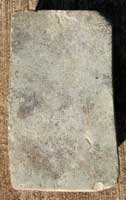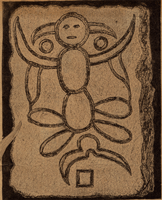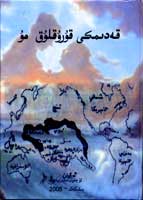This blog is part of the interactive media resources of my-mu.com and is used to discuss and investigate the theories of James Churchward and the Lost Continent of Mu.
Friday, December 15, 2006
Welcome Message Converted
See below:
Sunday, December 03, 2006
The Cascajal Block and the Lost Continent of Mu


Cascajal Block and Symbols
In September 2006, Science Magazine published a paper entitled "Oldest Writing In the New World". The item of note in the article and most widely reported was that the block showed what appeared to be a sample of the oldest writing ever found in the Americas. As this discovery took place in a location where William Niven had unearthed artifacts and relics in the early 20th century and some of these items were subsequently used as evidence by James Churchward of ancient civilizations - then this new discovery might have some bearing on my research.
The questions I want answered are:
1. How close were the discoveries by Niven to the Cascajal Block?
2. Does this ancient script have similar characters to the symbols discussed in the books by James Churchward ?
3. Does this new discovery prove, disprove, or have no bearing on the theories of James Churchward ?
In answering questions about William Niven and his digs in Mexico - I turned to the biography of William Niven entitled: "Buried Cities, Forgotten Gods."[Wicks and Harrison; Texas Tech University Press]


Niven's Tablet #1584
It is true that the 1926 'Lost Continent of Mu, Motherland of Man' had an entire chapter entitled "Niven's Buried Cities," but James' first contact with Niven was after the publication of the first book (September 19, 1927.) Their relationship, as determined from correspondence, is covered in "Buried Cities, Forgotten Gods." In 1928, Niven sent rubbings of some 2500 tablets from the Valley of Mexico to James. These were translated by James and found their way into the 1931 "Lost Continent of Mu" and the 1931, "Children of Mu." I have seen references to these rubbings having been published, however I am not aware of the location of the original or reproductions thereof. Whether or not James' interpretation was valid is left to different research, the preceding is background information to help calculate the distance between discoveries.
One location cited in the Mexico Valley was Atzcapotzalco (19.4889N 99.1836W.) The Cascajal Block was found in Cascajal, Veracruz-Llave (17.9500N 95.1167W). Using an online latitude/longitude calculator (http://jan.ucc.nau.edu/~cvm/latlongdist.html) and would place them 286.9 statute miles apart.




In answering question #2, I perused the 1926 Lost Continent of Mu, Motherland of Man, a 1969 reprint of the 1931 Lost Continent of Mu, a 1988 reprint of the 1959 printing of Children of Mu (originally published in 1931,) and the 1988 reprint of the 1960 printing of the Sacred Symbols of Mu (originally published in 1933.)
I could find no direct matches between the symbols on the Cascajal Block and any symbol in the aforementioned books. I looked at the symbols contained in the creation myth, I looked at the tables of primitive symbols and hieratic characters and I looked at the depictions of rock carvings.
 Cascajal Block Symbol #53 |  Symbol from Lost Continent of Mu (1931) page 53 |
The closest a symbol came to resembling a symbol in James Churchward's books is #3[& 16, 45, 53, 59.] The symbol at the top is referenced in numerous places as "Lands of the West" (Lost Continent of Mu, Motherland of Man page 53). The oblong shape beneath is not part of Churchward's theories. Michael Everson, on his website analysis of the Cascajal Block (http://www.evertype.com/gram/olmec.html) identifies the symbol as a pineapple, which is as good an explanation given the other symbols on the tablet.
Given that 28 (or 30 as interpretated by Michael Everson) unique symbols found on the Cascajal Block only one remotely resembles a symbol from an ancient civilization, then I would have to answer that there is no correlation between the symbols on the Cascajal Block and symbols discussed by James Churchward.
Does this discovery prove, disprove or have no bearing on the theories of James Churchward ?
Having no matches between the Cascajal Block symbols and those found in James Churchward's works does not prove or disprove anything, nor does the distances between where the objects were found. It might be said that the age of the artifacts could be different and that could account for the differences. Unfortunately, the Cascajal Block has no bearing on proving or disproving the theories of James Churchward, but still is an object to be studied in the hopes that one day, its secrets will be revealed to the world.
Further Links
- Stone Pages Archaeo News Printed Coverage
- Stone Pages Archaeo News Audio Coverage
- Archaeology Channel Printed Coverage
- Archaeology Channel Audio Coverage
- NPR Coverage
- LiveScience Coverage
- Research Paper (pdf format)
- Wikipedia
Jack Churchward
Clearwater, Florida
Sunday, November 12, 2006
Memorial Day 2006 Weekend with Uyghur Friends
There were a few reasons for our visit. While Cindy met with some Tibetan friends and received teachings from wonderful Rinpoches, I had hoped to meet with the man that translated and published the Lost Continent of Mu" into the Uyghur language. Unfortunately, he was not present, but I do have a copy now. More on the Uyghur language version of the "Lost Continent of Mu" in another posting.
Another reason was to interview an Uyghur historian friend about his thoughts about the "Great Uighur Empire." The theory about the 'Great Uighur Empire' occupies a whole chapter of the 1931 "Children of Mu," by James Churchward. The 'Great Uighur Empire' (as referenced by James) predates the historical Uighur Empire and is identified as the "Primary / First' colonial empire of the Land of Mu. James also states that 'the history of the Uighurs is the history of the Aryan Race.' James uses a reference from a Tibetan monastery to indicate that the Naacals brought copies of the Sacred Inspired Writings to the Uighur capital some 70,000 years ago. So, some time prior to this, the Empire was started. He goes on to explain that the cataclysm that raised the mountains ended the Uighur Empire and separated the Uighur peoples. This cataclysm, as described in James' writings, roughly corresponds to the Biblical flood.
One element of his theories involves the origin of the Chinese people and reflects a philosophy some today may find repugnant. Using a stereotypical white superman (the Uighurs) and stereotypical brutish savage (the Mongols) as parents, the Chinese people were developed. In two paragraphs, James gathers the racial prejudices of the 1920s & 30s and denigrates entire races of people with a stroke of his pen. While these stereotypes may be acceptable for the popular culture of the late 19th and early 20th century, the truth as documented indicates a different picture of the Mongols. Of course, if you only read the Persian accounts of Genghis Khan, you might believe the stories. Apart from reading numerous Asian and Central Asian history books, my experiences with the Mongolian people has also been personal. I have seen no evidence that my Mongol friends were not equals or are somehow different - I find these theories as offensive as my friends would.
I have read about the historical Uighur Empire that existed in what is now known as Mongolia and eventually migrated to Central Asia. The history of Central Asia is the history of the Uighurs - the Uighur people are a distinct, vibrant cultural element of Central Asia. Whether you examine the role of Uighur scholars in Genghis Khan's court as administrators, peruse the artistic wonders of their architectural accomplishments involving the Buddhist, Christian or Islamic periods, or read translations of the numerous written works on medicine, history or just their humor, one cannot but realize the unique and vital contributions of the Uighur people to history. Currently, the majority of the Uyghur people live under the rule of the Chinese government. I would be remiss were I not to mention that this centuries-old culture is under attack - Uyghur language text books are banned from classrooms and book burnings have consumed thousands of books, just for being correct about history. Aside from the Chinese government propaganda that equates an Uyghur identity with terrorism, there is not truth in this stereotype either. I also know this from personal experience.
Now that I have painted a brief picture of James' theories versus what I have learned, it should be easy to see why I wanted to speak with my Uyghur historian friend. Due to contractual obligations and family safety, he was reluctant to be interviewed for a podcast or have his name mentioned. We did spend an evening together and talked about this subject. He said he also had a copy of the Uyghur language translation of "The Lost Continent of Mu" and had been conducting his own research into this topic. 'Erkin' is a methodical researcher with impeccable credentials - I expect his research to be the definitive answer when it is published.
So I am left with no further references from independent sources concerning James Churchward's claims about 'The Great Uighur Empire.' There is one article in one of James' scrapbooks that gives reference to Koslov but I was hoping to gather further sources. This theory was also studied by the father of the Turkish nation, Mustafa Kemal Ataturk.
To continue this study of the 'Great Uighur Empire,' I call on interested parties to send your ideas, comments, and references to a common location - open and available for viewing by everyone. Please add your comments below, or send your contribution to gue-list@my-mu.com - a new mailing list with an open subscription policy. If you have something to discuss or just want to read the results, please join here.
Sunday, October 29, 2006
Research Update - October 2006
This past summer has been busy at my-mu.com, although unless you have visited the website, you may not have noticed it. First, information about James Churchward and his theories of a lost Pacific Ocean continent continues to stack up here. Here are some of the high-points, each will be addressed in a separate posting to our blog and/or occupy a new and unique webpage.
|
2. Although we had heard about the Uyghur language translation of the "Lost Continent of Mu," we had not seen a copy. We now have a copy from Kazakhstan. |  Uyghur Language version of The Lost Continent of Mu | |
 "Olga Muriel" born 1873 |
|  "Gladys Stella" born 1874 |
 Frontispiece from Lost Continent of Mu 1988 Paperback |
|  "Relics" from Mu |
 Niven's Tablet #1584 |
|  Discovered tablet from 2006 |
| To keep up-to-date on our research, please join our announcements mailing list which can be accessed from our interactive media page on our website. This is a low volume mailing list that promises to keep the number and size of emails small and to the point; we don't like spam either. Second, there has been a complete update of my-mu.com. The old frames version of the website is gone and has been replaced with an easier, more accessible version. We have added a new section on James Churchward's research materials that contain thumbnails of each of the pages. While these may not be entirely legible, at least one of the thumbnails is an active link that will take you to a full-size scan of that sheet. To keep things interesting, the link will periodically change. |
| We are also posting articles by James that are being transcribed from his research materials. The first such article entitled "The Sun is Not a Superheated Body, He Declares," has provoked discussion. And some of his other works when released will also likely continue to challenge the status quo and bring the theories of James Churchward into focus. |
| Lastly, we are pleased to announce the immediate availability of three never before published elements of James Churchward's research materials. As described by Percy Tate Griffith in his biography of James, "Churchey" as he was known, was in contact with thousands of people across the globe. "Lost Gems of the Lost Continent of Mu: Reviews and Correspondence from James Churchward's Scrapbooks Volume 1 is partial evidence of the vast network of his contacts. A free preview is available online at the My-Mu.com Bookstore.
|
| And finally, as a side-note:
|
Sunday, May 07, 2006
An Interview with Dick Lowdermilk
Dear friends, This past Saturday (April 29, 2006,) I spent some time with Dick Lowdermilk of South Carolina. Dick recently purchased the rights and published the updated version of "My Friend Churchey and His Lost Sunken Island of Mu," the biography of James Churchward. |  |
 | Originally penned in 1937 by Percy Tate Griffith, this work had remained unpublished for over sixty years. The original manuscript remained in the procession of his daughter Joan, and portions that had reportedly been lost, have been found. This work shows a different side of James - by someone who knew him over the course of decades. |
| As James' long-time friend and patent attorney, PTG, as he was also known, provides an account from the perspective of someone whose karmic threads are intertwined, not a casual acquaintance. PTG witnessed first hand the discussions between James Churchward and Dr. Augustus LePlongeon in his mother's parlor as well as countless other encounters. PTG even represented 'Churchey' in a $1,000,000 lawsuit against a major steel corporation. Percy Tate Griffith's first hand knowledge, observations, and recollections are the clearest glimpse of James, the person. The table of contents and complete first chapter of the original manuscript have been scanned and are available online at www.-my-mu.com. |
I recorded a short, unrehearsed and informal podcast and it is available for download. A transcript will be made available shortly. |  Click for Podcast |
To order a copy of the 1937 biography of James Churchward, entitled: "My Friend Churchey and His Lost Sunken Island of Mu," please contact Dick Lowdermilk directly.
|